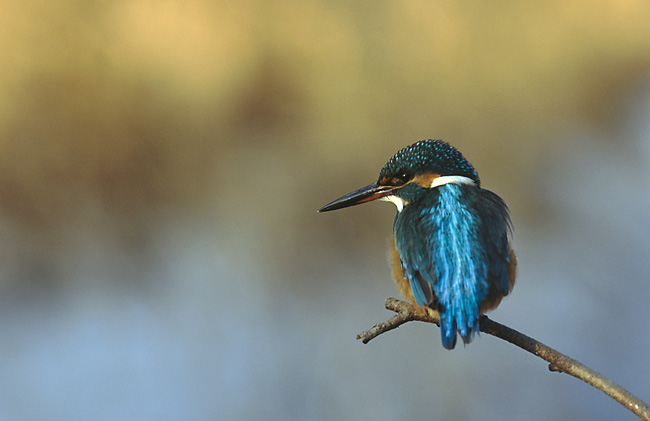|
| 질의: white shrimp | 결과: 39번째/74 | |
Common Kingfisher (Alcedo atthis) - Wiki
| 제목: | Common Kingfisher (Alcedo atthis) - Wiki
| |

| 해상도: 650x421
파일크기: 62396 Bytes
등록시간: 2006:12:25 08:36:43
|
European Kingfisher
From Wikipedia, the free encyclopedia
Order: Coraciiformes
Family: Alcedinidae
[Photo] Common Kingfisher, Alcedo atthis. Author: Marek Szczepanek http://commons.wikimedia.org/wiki/User:Pkuczynski/Marek_Szczepanek
The European Kingfisher or Common Kingfisher, Alcedo atthis, is widely distributed in Europe, Africa, and Asia. It is resident except in northern areas where the rivers freeze. It will then move to milder regions. In most of its European range it is the only kingfisher.
The general colour of the upper parts of the adult bird is bright metallic blue, cobalt on the back, and showing greenish reflections on the head and wings. The ear coverts and under parts are warm chestnut, the chin and sides of neck white.
The bill is blackish and reddish orange at the base; the legs are bright red with a dark blue stripe. In the young the bill is black. Length averages 19 cm (7.5 inches) and wings average 7.5 cm (2.95 inches).
The flight of the Kingfisher is rapid, the short rounded wings whirring until they appear a mere blur. It usually flies near the water, but during courtship the male chases the female through and over the trees with loud shrill whistles.
From February onwards the male has a trilling song, a modulated repetition of many whistles. He also signals with a whistle to the female when he is feeding her, this being his share of the nesting duties. This whistle is produced even when his bill is loaded with food, yet is clear and distinct. The female will reply and emerge from the nesting hole, and may fly to meet him, take the fish from him in the air, and return to the nest.
The bird has regular perches or stands from which it fishes. These may be a few inches or many feet above the water. It sits upright, its tail pointed downwards. It drops suddenly with a splash and usually returns at once with a struggling captive.
Large fish are beaten on a bough or rail; small fish and insects are promptly swallowed. A fish is usually lifted and carried by its middle, but its position is changed, sometimes by tossing it into the air, before it is swallowed head downwards.
The Kingfisher sometimes hovers over the water, with body held almost vertical, the tail and head bent slightly forward and the bill inclined downward.
It is a bird of the waterside, since it feeds entirely upon aquatic animals. It is frequent beside lakes, ponds, canals or dykes and streams.
In winter, especially when inland waters are icebound, it may move to tidal marshes and the shore, taking its stand on the mussel or limpet covered rocks and diving into the shallow pools.
Fish, aquatic insects and crustaceans are eaten. It eats numerous freshwater shrimps Gammarus.
The nest is a tunnel in a sandy bank, usually, though not always over water. Both birds excavate, except when an old hole of a Sand Martin or Water Vole is appropriated. Most incline upward for about three feet before the nesting chamber is reached.
There is no nest, but the six to seven or even more round white eggs are placed on a litter of fish bones and disgorged pellets. The eggs are pink. The first clutch is usually laid in April, but second broods are often in the nest at the end of July, and an exceptional case of young in early October is recorded.
The young come to the mouth of the hole to be fed when old enough. They are at first without down and clothed with numerous small blue feathers. Their bills are steel-blue and their feet lighter colored than adults. When they leave the nest they differ little from their parents, except that the colours are duller, the spot on the neck is buff, and the grey margins to the breast feathers give a mottled appearance. Their call is then an insistent, continuous trill.
http://en.wikipedia.org/wiki/European_Kingfisher
| The text in this page is based on the copyrighted Wikipedia article shown in above URL. It is used under the GNU Free Documentation License. You may redistribute it, verbatim or modified, providing that you comply with the terms of the GFDL. |
|
댓글 |
|---|
| | 손님 |
|
| 물총새 Alcedo atthis (Common Kingfisher) |
| | 손님 |
|
Scientific Name: Alcedo atthis (Linnaeus, 1758)
Common Names: Common Kingfisher, Kingfisher, European Kingfisher
French: Martin-pêcheur d’Europe; German: Eisvogel; Spanish: Martín pescador común
Taxonomy: Gracula Atthis Linnaeus, 1758, Egypt. |
^o^
동물그림창고 똑똑전화 누리집
^o^
|
|
|